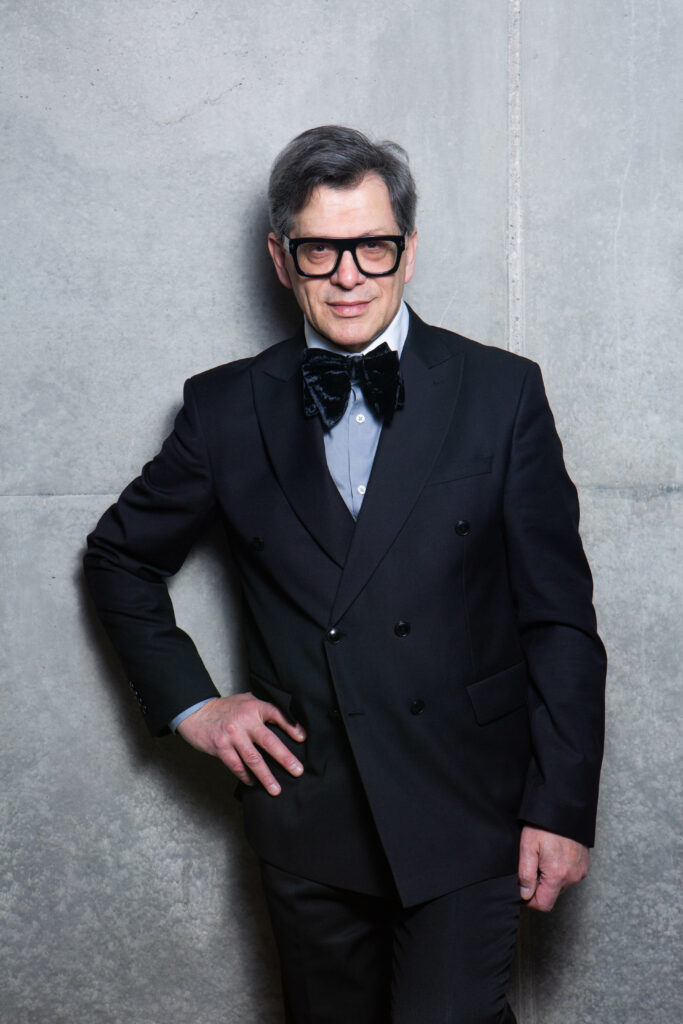Professor Eugenijus Skerstonas, a distinguished academic at Kazimieras Simonavičius University and Doctor of Social Sciences, stands out as one of Lithuania’s leading cultural and intellectual figures. He is widely recognised for his work on the culture of appearance, style, aesthetics, and lifestyle, having authored numerous scholarly and popular albums. In recognition of his contribution to culture, Professor Skerstonas was awarded the Order of Arts and Letters by the Republic of France. 
At this year’s Vilnius Book Fair, he presented his latest work — a trilingual, three-volume edition entitled Private Vilnius: Lives of Interiors. This commemorative publication, marking the 700th anniversary of Vilnius, invites readers to explore the capital’s identity through the lens of private interior aesthetics and cultural narratives. It is available in Lithuanian, English, and Polish.
We spoke to the professor about the origins of this unique project, created in collaboration with photographer Augis Narmontas, and what readers can expect to discover within its pages.
– How did this ambitious and expansive project come about?
– My intention was to showcase the rich diversity of Vilnius’s private residential interiors and their distinctive ornamentation. I sought to document what often remains hidden — private spaces that reflect our culture, traditions, and varying interpretations of aesthetic value.
– The interiors featured are not stylised or staged for photography. Why did you choose a documentary approach?
– It was important for me to capture these living spaces exactly as they were on the day of the shoot. This three-volume work is a form of visual documentation, offering an authentic portrayal of how Vilnius residents live and express their aesthetic preferences. We photographed the interiors in the way their owners had envisioned and decorated them.
– In your view, how does interior decoration reflect a person’s character?
– A home is a reflection of our lifestyle culture — a metaphor rooted in reality. As I’ve often said, interiors serve two main functions: one practical, the other aesthetic. Each individual interprets their environment differently, so interiors become not just physical spaces, but a means of self-expression. They reveal artistic intuition or awareness, cultural background, and even a person’s worldview and emotional landscape.
 – Your publication is available in Lithuanian, English, and Polish. Was it your aim to reach an international audience?
– Your publication is available in Lithuanian, English, and Polish. Was it your aim to reach an international audience?
– Absolutely. Vilnius is a cosmopolitan city with deep historical ties to many cultures. I wanted the book to be accessible not only to Lithuanians but also to international readers interested in the city’s history, architecture, and interior design heritage.
– What kinds of interiors can readers expect to find in these volumes? Could the book also be seen as part of Vilnius’s historical narrative?
– The interiors presented include both contemporary private homes and those that bear witness to the past — sometimes a very distant one. Many spaces have been substantially altered by previous owners, but we also found places where, quite remarkably, original elements have survived. Without doubt, interiors form an essential part of Vilnius’s history. They evoke images of past lives and lived experiences within these walls.
– How have Vilnius’s residential interiors evolved over time, in your opinion?
– The passage of time has had a profound impact on interior decoration. Every era brought new owners who reimagined their intimate environments. Today, interior researchers attempt to trace the dominant trends of the past, identifying key stylistic characteristics. For instance, Gothic and Baroque Vilnius had its own aesthetic sensibilities, which changed dramatically during the Soviet period. Since Lithuania regained independence, we’ve seen a shift towards European influences. In recent years, there has been a stronger emphasis on individuality — people are rethinking what luxury means, yet still seeking comfort, and blending it with function and a personal sense of beauty.
– As both a Doctor of Social Sciences and a lifestyle culture expert, how do you see this field connecting with interior design?
– Thank you for the thoughtful observation. Lifestyle culture touches on many areas related to spirituality and imagination, including how we shape our living spaces. An interior is not just furniture and colour schemes — it influences our mood, reflects our daily culture, and can even shape our worldview. I believe it’s essential to discuss how aesthetics, function, and personal space can contribute to human well-being. Just take a look at the stunning photographs that capture the authentic quality of life in Vilnius.
– Where can readers find your new three-volume publication?
– The album Private Vilnius: Lives of Interiors was released during the anniversary year and is now available in libraries, major online bookshops, and on the Žara publishing house website.
Share: